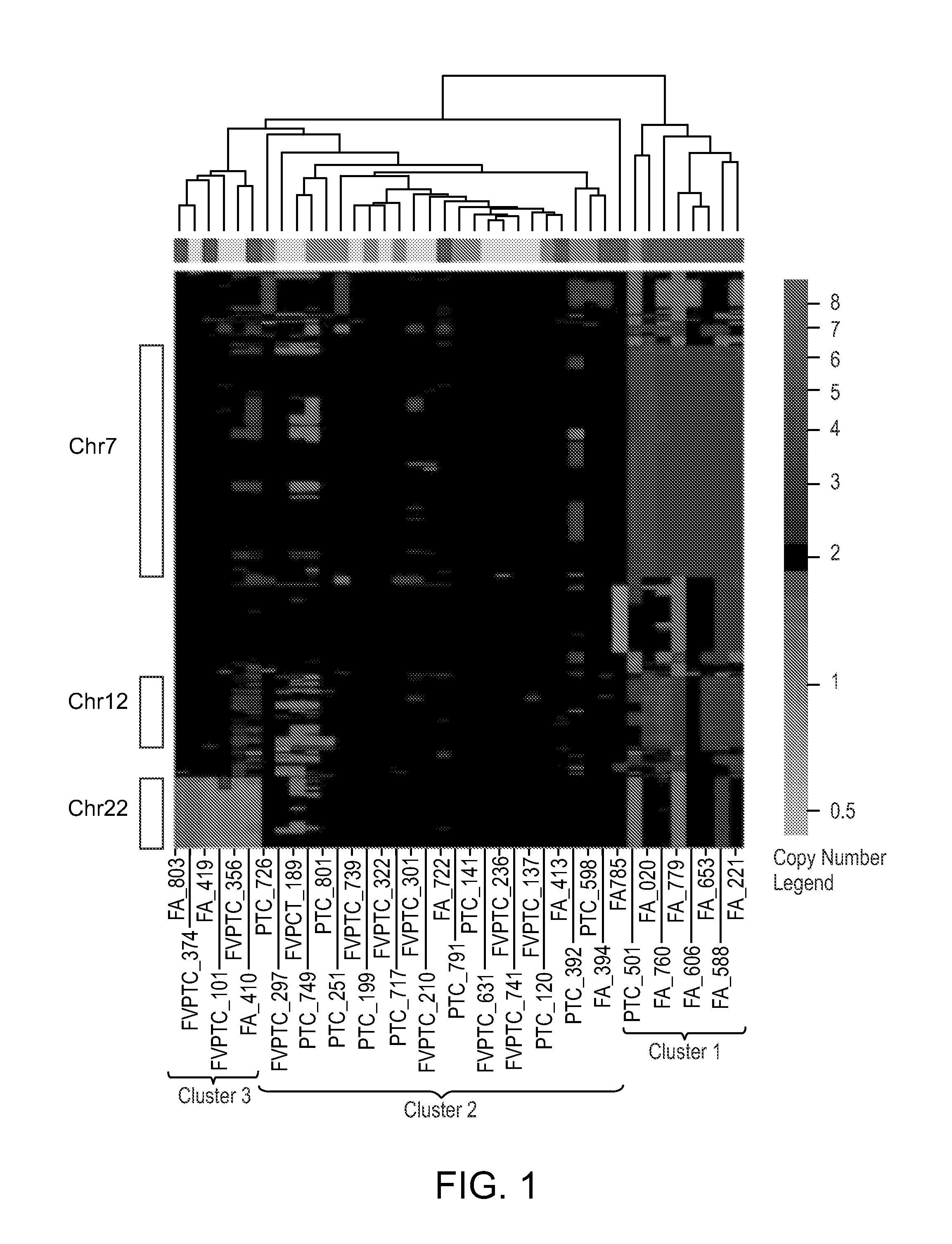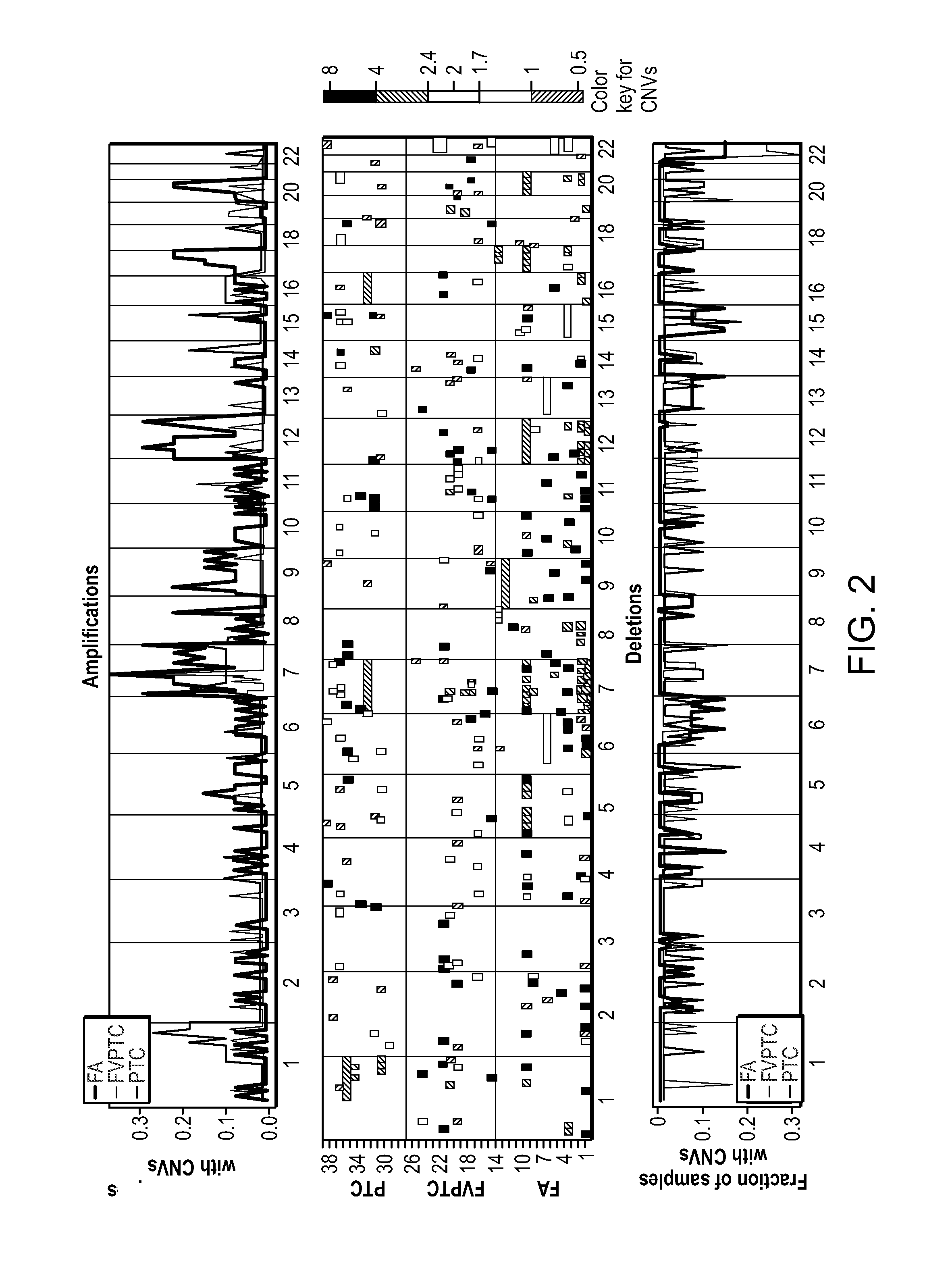Compositions and methods for characterizing thyroid neoplasia
a thyroid and neoplasia technology, applied in the field of compositions and methods for characterizing thyroid neoplasia, can solve the problems of particularly difficult diagnosis of fvptcs and ptcs, and insufficient sensitive and specific assays
- Summary
- Abstract
- Description
- Claims
- Application Information
AI Technical Summary
Benefits of technology
Problems solved by technology
Method used
Image
Examples
example 1
Characteristic Genomic Copy Number Variation Patterns are Associated with FAs, FVPTCs, and PTCs
[0132]Using Illumina 550K SNP arrays, genome-wide DNA copy number changes were investigated in 39 thyroid tumors (14 FAs, 13 FVPTCs, and 12 PTCs) with paired normal thyroid tissue samples from the same patients as controls (See Table 1 and Table 2 for clinical patient information).
TABLE 1Clinical information summary of tissuesample cases used in this studyTumorTotalMedianMedianTumorType(M / F)AgeSize (cm)Stage (n)Discovery patient cohort for SNP array analysisFA 3 / 11423.2FVPTC 2 / 11474I (8), II (2), III (2), IV (1)PTC3 / 942.52.5I (7), II (1), III (1), IV (3)Validation patient cohortFA 6 / 12512.7FVPTC2 / 8373.2I (6), II (2), III (1), IV (1)PTC3 / 6482I (6), II (1), III (1), IV (1)FC5 / 2554I (4), III (3)HC2 / 3563.5I (1), II (1), III (2), IV (1)AN 2 / 1050.52.9Total23 / 61463.2
TABLE 2Clinical Information of the thyroid tumor samples used in this study.Subtype_Case no.TumorInvasiveGeneticBRAF(Id)Age / Sexsize ...
example 2
FAs are Enriched for the Presence of Chromosomal Amplifications Relative to FVPTCs and PTCs
[0135]Statistical analysis was performed to identify significant CNVs as genomic amplifications and deletions (see, e.g., FIG. 7). The rule for identifying significant CNVs depended on the number of SNPs involved, as well as the magnitude of the copy number change, and was designed to ensure that type I error did not exceed 10%. A total of 464 CNVs were identified as significant genomic aberrations as shown in Table 3A.
TABLE 3ADetected CNVs in individual thyroid tumor samples.ID*SNP copy number gainSample# SNPID*CytobandStartStopSize (bp)markersValueS11p36.1319,705,15419,800,14094,986170.311q21.2148,577,451148,638,01860,56750.492p11.288,428,89288,554,147125,255250.252q22.2144,504,859144,585,51480,65550.452q32.3192,090,179192,100,18610,00760.423p25.112,611,25512,704,48593,230170.305q13.1-q13.268,374,87568,701,565326,690380.296p11.1-6q11.158,822,89662,027,4923,204,59670.406q1588,450,67788,576,98...
example 3
Sets of 5-50 Copy Number Variant Genes Accurately Distinguish Benign FAs from Malignant FVPTCs and PTCs
[0136]To identify genes in which copy number differed by tumor type, the original segmented data was mapped to genes and analyzed by an ANOVA, and the Type I error was controlled by the Benjamini-Hochberg false discovery rate and maintained at a level less than 10%. A total of 1209 genes for which DNA copy number showed significant differences (adjusted P<0.05) between FAs and FVPTCs / PTCs were found. The majority of these genes were located on chromosomes 7, 12, and 17. The dominant CNV pattern was determined to be low level but widespread copy number gain of Ch12 in FAs, as illustrated in FIG. 3A-C, which show the mean fold changes across all samples on Ch7, Ch12, and Ch22, separated by tumor subtype.
[0137]To obtain a gene set whose CNVs could distinguish benign FAs from malignant PTCs and FVPTCs, the top 10 ranked genes on Ch12 were selected, ordered according to their statistica...
PUM
| Property | Measurement | Unit |
|---|---|---|
| temperatures | aaaaa | aaaaa |
| temperatures | aaaaa | aaaaa |
| temperatures | aaaaa | aaaaa |
Abstract
Description
Claims
Application Information
 Login to View More
Login to View More - R&D
- Intellectual Property
- Life Sciences
- Materials
- Tech Scout
- Unparalleled Data Quality
- Higher Quality Content
- 60% Fewer Hallucinations
Browse by: Latest US Patents, China's latest patents, Technical Efficacy Thesaurus, Application Domain, Technology Topic, Popular Technical Reports.
© 2025 PatSnap. All rights reserved.Legal|Privacy policy|Modern Slavery Act Transparency Statement|Sitemap|About US| Contact US: help@patsnap.com



